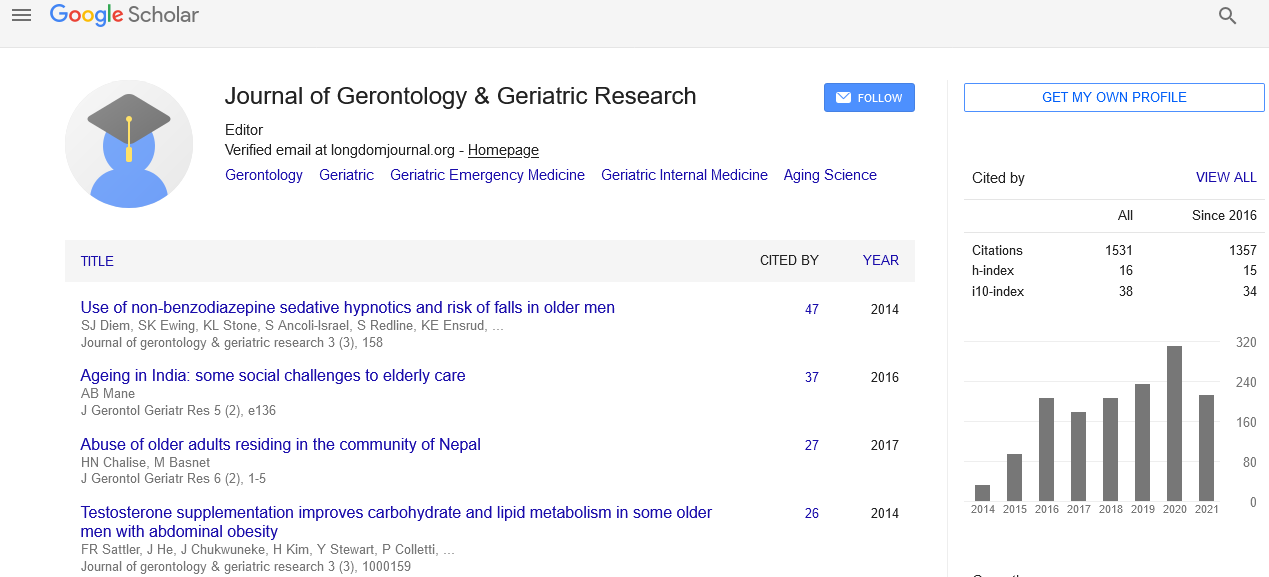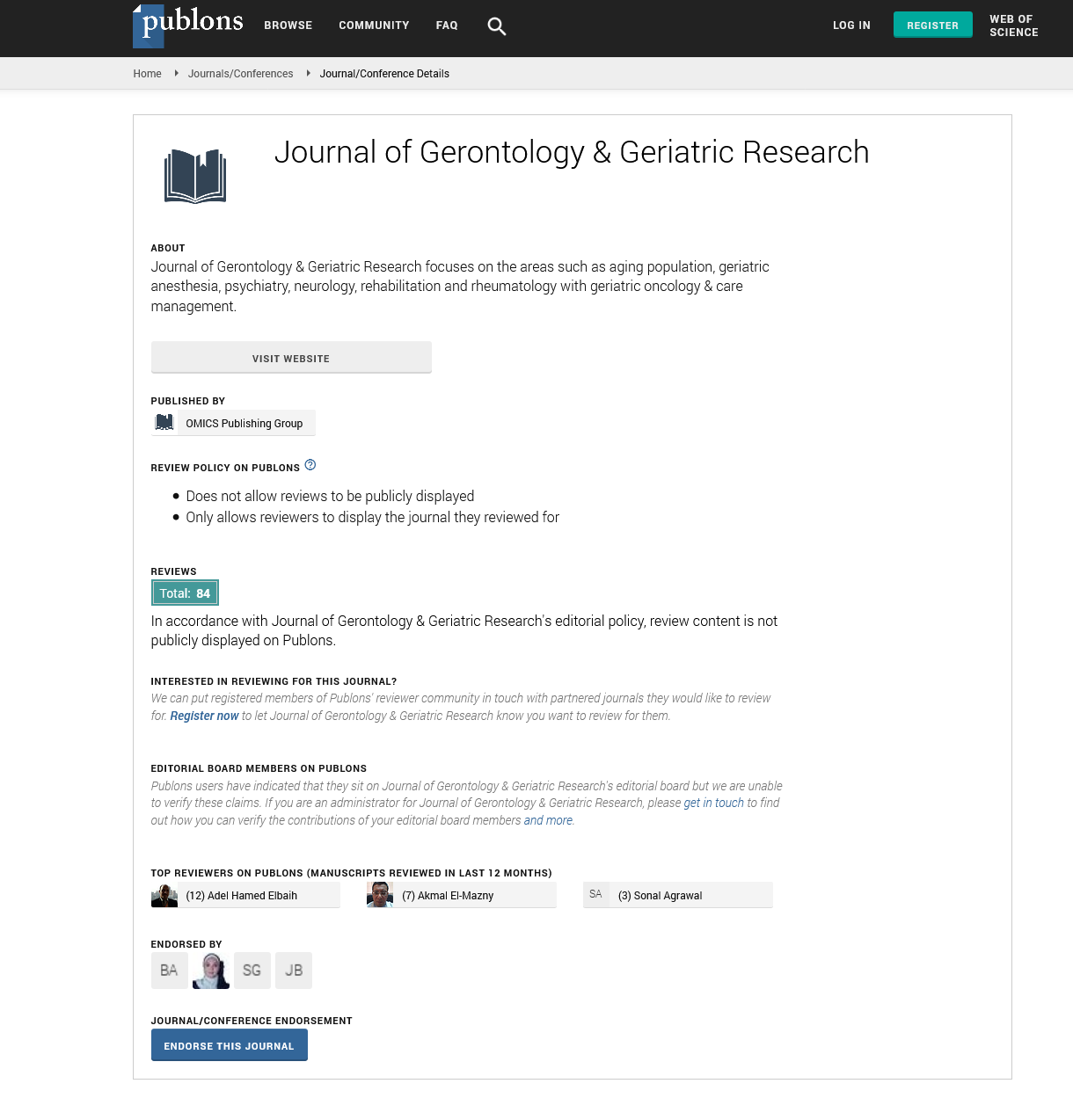PMC/PubMed Indexed Articles
Indexed In
- Open J Gate
- Genamics JournalSeek
- SafetyLit
- RefSeek
- Hamdard University
- EBSCO A-Z
- OCLC- WorldCat
- Publons
- Geneva Foundation for Medical Education and Research
- Euro Pub
- Google Scholar
Useful Links
Share This Page
Journal Flyer

Open Access Journals
- Agri and Aquaculture
- Biochemistry
- Bioinformatics & Systems Biology
- Business & Management
- Chemistry
- Clinical Sciences
- Engineering
- Food & Nutrition
- General Science
- Genetics & Molecular Biology
- Immunology & Microbiology
- Medical Sciences
- Neuroscience & Psychology
- Nursing & Health Care
- Pharmaceutical Sciences
Editorial - (2022) Volume 11, Issue 5
Editorial Note on Geriatric Population
Celia Divino*Received: 02-May-2022, Manuscript No. jggr-22-17192; Editor assigned: 04-May-2022, Pre QC No. P-17192; Reviewed: 12-May-2022, QC No. Q-17192; Revised: 18-May-2022, Manuscript No. R-17192; Published: 23-May-2022, DOI: 10.35248/2167-7182.2022.11.611
Editorial
This longevity revolution is affecting all societies throughout the world, with some at an early stage and others at a later level. However, everyone will go through this exceptional change, in which the chances of survival are slim to none. to 65 years old grows from less than 50% in the 1890s in Sweden to more than 90% nowadays At the moment, the countries with the highest life expectancy are accounting for a quarter of the world's population. Furthermore, the percentage of adult life spent in most affluent countries, the proportion of people over 65 climbed from less than a fifth in the 1960s to a quarter or more today. Individual transformations are mirrored in societal transformations: The number of people above the age of 65 is increasing. a societal group More than one-third of the population is over the age of 65 [1].
All nationals present in, or temporarily absent from, a country, as well as aliens permanently resident in a country, are considered part of the population. This metric depicts the average number of people who dwell in a given location. The annual changes in population due to births, deaths, and net migration during the year are referred to as growth rates. National armed forces stationed abroad; commercial seafarers at sea; diplomatic staff stationed abroad; civilian immigrants residing in the country; displaced persons resident in the country make up the total population. Foreign armed troops stationed in the country; foreign diplomatic staff stationed in the country; and civilian immigrants temporarily in the country are all excluded. A typical demographic tool is population forecasts. They serve as a foundation for other statistical projections, assisting governments in their decision-making. For understanding the impact on society and the economy, as well as to guide policies and programmes, detailed information and data on population ageing and the older population are essential [2].
Medical care for older persons is referred to as geriatrics, a broad term that encompasses a wide range of age groups. The study of ageing, encompassing physiological, sociologic, and psychological changes, is known as gerontology. The term "older" is preferred over "elderly," but both are imprecise. It's critical to avoid phrases and attitudes that imply prejudice against the elderly (ageism). Although there is no standard age to define older age, the term "over 65" is frequently used because this is the age at which people in the United States become eligible for Medicare insurance. Some persons with medical issues, on the other hand, need geriatrics competence at a younger age. For example, the Program of All- Inclusive Care for the Elderly (PACE) has a 55-year-old eligibility age for adults who need nursing care [3].
The proportion of the world's population aged 60 and up will nearly double from 12 percent to 22 percent between 2015 and 2050. By the year 2020, the number of persons aged 60 and more will outweigh youngsters under the age of five. By 2050, 80% of the world's elderly would live in low- and middle-income countries. The population is ageing at a considerably higher rate than in the past. Every country faces significant hurdles in ensuring that its health and social systems are prepared to take advantage of this demographic transformation. People are living longer all across the planet. Most people nowadays can expect to live well into their sixties and beyond. Every country in the globe is seeing an increase in the number and proportion of elderly people [4].
Many elderly people have many chronic illnesses as well as physical and cognitive weakness. Traditional methods of assessing and enhancing the quality of medical care do not always work effectively in this situation. This is because previous procedures were designed for single diseases and younger persons, and do not account for the widespread occurrence of numerous illnesses, functional impairments, and reduced life expectancy as people age. In this scenario, our research group is pioneering new approaches of measuring and improving care quality [5].
Conflicts of Interest
The authors declare no conflict of interest.
REFERENCES
- Ebrahim SH. Covid-19 and community mitigation strategies in a pandemic. BMJ. 2020;368.
- Giebel C. A UK survey of COVID‐19 related social support closures and their effects on older people, people with dementia, and carers. Inter J Geriatric Psychiatry. 2021;36:393-402.
- Maier W. The Hamilton Anxiety Scale: reliability, validity and sensitivity to change in anxiety and depressive disorders. J Affective Disorders. 1988;14:61-68.
- Pieh C. The effect of age, gender, income, work, and physical activity on mental health during coronavirus disease (COVID-19) lockdown in Austria. J Psy Res 2020;136:110186.
- Yesavage JA. Development and validation of a geriatric depression screening scale: A preliminary report. J Psychiatric Res. 1982;17:37-49.
Google Scholar, Crossref, Indexed at
Google Scholar, Crossref, Indexed at
Google Scholar, Crossref, Indexed at
Google Scholar, Crossref, Indexed at
Citation: Divino C (2022) Editorial Note on Geriatric Population. J Gerontol Geriatr Res. 11:611.
Copyright: © 2022 Divino C. This is an open-access article distributed under the terms of the Creative Commons Attribution License, which permits unrestricted use, distribution, and reproduction in any medium, provided the original author and source are credited.


